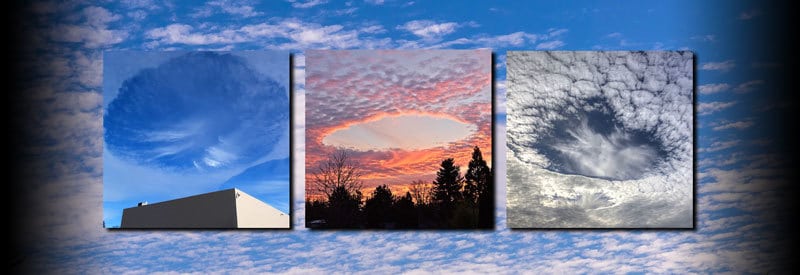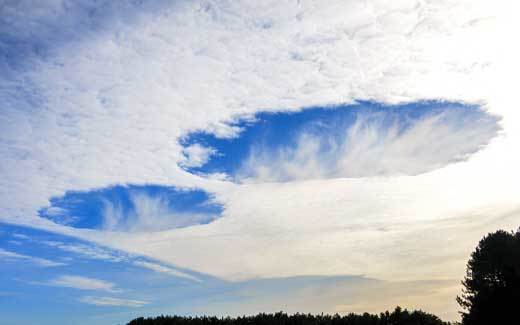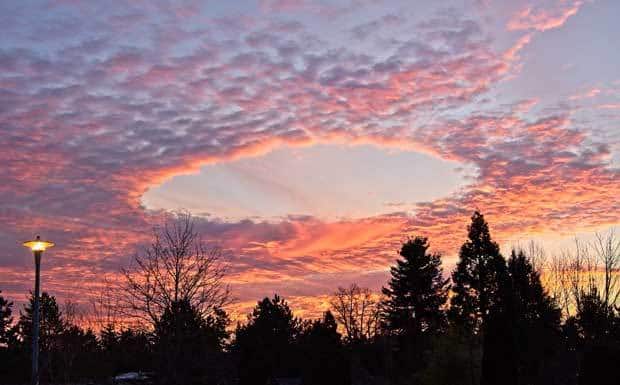Fallstreak Holes: What They Are And How They Form

Certain meteorological events, specifically cloud formations, often have unique but also puzzling characteristics. Fallstreak holes are one such occurrence, but what are they, and how do they form?
Fallstreak holes are large circular or oval-shaped openings that form in cirrocumulus or altocumulus clouds when supercooled water is turned into ice crystals, causing the surrounding water droplets to evaporate. This occurrence is predominantly the result of aircraft passing through a cloud.
If you found yourself at the right time and place, you may have been in the unique position of observing what looked like a large appearing what seems to be spontaneously in a cloud formation.
These appearances may look very unnatural and are often confused with Unidentified Flying Objects (UFOs) or other artificial objects. Although they may seem artificially created objects, it is the result of a natural process, which was initiated by a manmade object.
In the following sections, we take a closer look at what fallstreak holes (also known as punch hole clouds) are and how they develop.
What Are Fallstreak Holes?
Before taking a more detailed look at how fallstreak holes develop, one needs to establish a more elaborate and detailed look at the definition and characteristics of this phenomenon.
Fallstreak Hole Definition

Fallstreak holes are large circular or oval-shaped openings that form in cirrocumulus or altocumulus clouds when supercooled water is turned into ice crystals, which also causes the surrounding water droplets to evaporate.
This occurrence is predominantly caused by aircraft passing through the clouds, which triggers the formation of ice crystals and the evaporation of water droplets behind it.
Also known as punch hole clouds, cavum, skypunch, or canal clouds, these meteorological phenomena predominantly occur in mid to high-level clouds such as altocumulus or cirrocumulus clouds at heights of 3 -12 kilometers (2 - 7 miles).
At these high altitudes, clouds primarily consist of supercooled water, which creates the perfect environment for the development of fallstreak holes.
As already mentioned, the development of these phenomena is primarily caused by aircraft as they pass through high-level clouds. Exactly how this occurs will be discussed in detail in the upcoming section.
Although fallstreak holes normally take the shape of a circle or oval, they can also develop in other forms, specifically cigar-shaped forms. This can be attributed to the angle at which an aircraft passes through a cloud.
A circular or oval-shaped hole is typically the result of an airplane passing through the cloud at an acute angle. When the approach through the cloud is more shallow, though, the aircraft spends more time in the cloud, which results in the cigar-shaped hole.
How Fallstreak Holes Develop

The following list details the development of fallstreak holes, starting with the conditions that need to be in place to make their formation possible:
- 1For fallstreak holes to form, altocumulus or cirrocumulus clouds must be present, which have both the right appearance and are situated at the appropriate altitude, creating the right environment for the second requirement to form.
- 2This allows for the presence of supercooled water, the second requirement. (Supercooled water is water droplets that dropped below freezing point but are still in liquid form due to the absence of a nucleus for ice crystals to form around.)
- 3Since ice crystals need nuclei like microscopic dust or pollen particles to form on or drop below -40° Celsius (-40° Fahrenheit) to spontaneously develop, supercooled water in the mid to upper-level clouds needs another impetus to freeze.
- 4An aircraft passing through the clouds provides this impetus. The wings or propeller blades force the air in its wake to expand, causing it to cool down in the process. This drop in temperature is enough to allow ice crystals to form.
- 5As ice crystals with enough weight form behind the aircraft, it falls to the ground, creating an opening where the plane passed through.
- 6This process also causes surrounding ice crystals to form, which generates enough heat (as a result of the Wegener–Bergeron–Findeisen process) to cause a domino effect where the surrounding water droplets start to evaporate.
- 7The combination of ice crystal formation and the evaporation of water droplets allows for the opening to expand rapidly, resulting in the large hole we view from the surface as fallstreak holes or punch hole clouds.
- 8Depending on the angle at which the aircraft passes through the clouds, the shape of a fallstreak cloud can vary from circular or oval to cigar-shaped.
Conclusion
Although fallstreak holes may appear very unnatural, there is a perfectly logical explanation for their development, as this article clearly illustrated.
Actually, they are a combination of a natural process combined with an artificial object. The natural mechanisms involved in the formation of ice crystals and the evaporation of water droplets are initiated by an artificial object in the form of an aircraft passing through clouds.
Never miss out again when another interesting and helpful article is released and stay updated, while also receiving helpful tips & information by simply clicking on this link .
Until next time, keep your eye on the weather!
